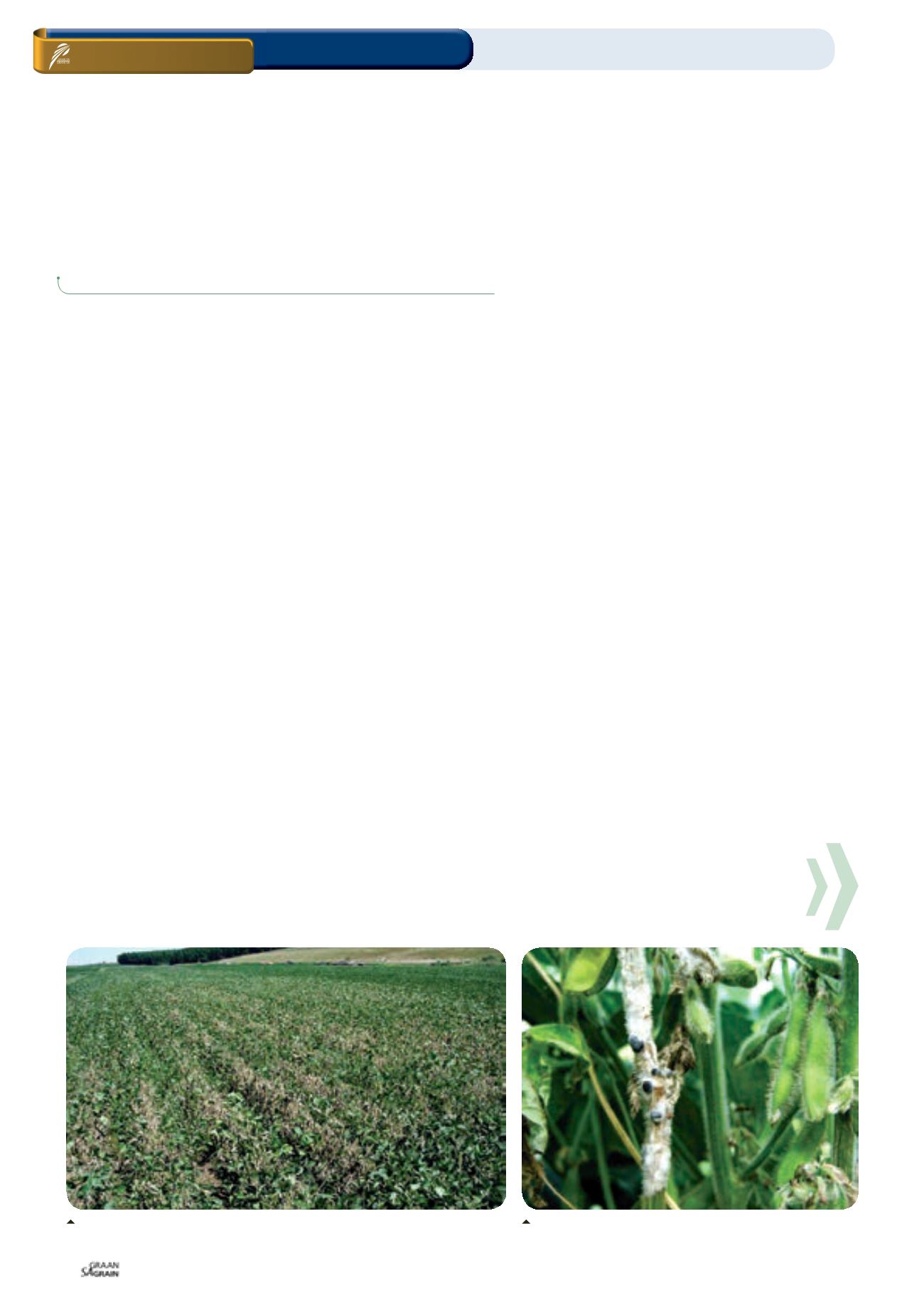
Maart 2014
102
Sclerotinia stem rot
poses a potential threat to soybean production
S
clerotinia stem rot of soybean is caused by the fungal
pathogen,
Sclerotinia sclerotiorum
(Lib.) de Bary. The
pathogen was first confirmed in South Africa in 1979,
however, it occurred locally long before then.
Losses can result either directly from loss of yield or indirectly from
reduced grain quality. Losses due to Sclerotinia on soybean are
estimated to be as high as 60% in South Africa in certain seasons
and localities.
Signs and symptoms
Infections occur anytime during flowering and symptoms can be
observed on leaves, pods, seeds and stems. Visual symptoms can
be observed when the crop canopy between rows has closed, thus
creating the ideal humid microclimate for infection and disease
development. Primary symptoms include wilting and withering of
leaves followed by plant death (
Photo 1
).
A closer look within the crop canopy will reveal a cottony, white
mycelial mass growing on stems, leaves and/or pods (
Photo 2
).
Lesions develop on the main stems and side branches, until the stem
and upper plant parts eventually die. Stems appear bleached and
sometimes shredded from advanced decay. Large, black sclerotia
form from the white mycelium growing on plant tissues and in the
stem pith (
Photo 3
).
Seeds in diseased pods are usually shrivelled and may be infected
by the fungus or replaced by black sclerotia. The seed is usually
contaminated with sclerotia when infected plants are harvested.
Disease epidemiology
Disease occurs primarily after the closing of the crop canopy, thus
promoting cool temperatures and a humid microclimate around the
stems and maintaining high soil moisture following rain or irrigation.
Infection occurs either by ascospores (carpogenic) or mycelial
(myceliogenic) germination. For carpogenic infection, the sclerotia
germinate when there is high soil moisture and produce mushroom-
like apothecia (
Photo 4
).
The apothecia release the ascospores in the air where they are
carried by air currents to soybean plants. Ascospores require a film
of water and a nutrient base such as dead or senescing flower tissue
to germinate and grow before plant infection takes place. Infection
often starts in the stem axils where senescing flower tissue have
fallen or lodged.
Myceliogenic infection occurs when sclerotia germinate in the
presence of exogenous nutrients and produce hyphae that invade
non-living organic matter. The mycelium subsequently penetrates
the host cuticle by mechanical pressure. Infection may also occur
through wounds caused by insects or other injury. Soybeans are
most susceptible to infection by the fungus during early reproductive
growth stages, when dying flower petals remain attached to the
developing pods.
A film of water on the plant surface promotes the development of
lesions and increases the amount of tissue damage. Initial disease
development requires lengthy periods of cloudy, humid, rainy
weather. The greater the density of the plant canopy, the more
favourable the environmental conditions for disease. Sclerotia
will be formed as the mycelium grows in and on the plant tissue.
Sclerotia can survive for a period of up to seven years in the soil,
particularly in dry soil conditions.
Management
Variety selection
The most important control strategy for Sclerotinia rot of soybeans
is through proper variety selection. It is advisable to choose less
susceptible varieties or varieties which have shown high yield under
disease pressure when planting in soils with a history of the disease.
Canopy management
Under low to moderate disease pressure, white mould increases as
the row spacing is narrowed. Disease risk is reduced on 40 cm row
spacing compared to 20 cm spacing. Under high disease pressure,
row spacing may have no effect on disease severity. Narrow row
production soybeans almost always have higher disease levels than
wider rows, but narrow rows favour higher yields.
ON FARM LEVEL
Soybean / Sclerotinia stem rot / Pathogen / Symptoms
Pest control
MOSES RAMUSI
and
BRADLEY FLETT,
ARC-Grain Crops Institute, Potchefstroom
1: Soybean field infected with Sclerotinia stem rot showing typical wilting and
death of leaves.
Photo: Pannar Seed
2. White, cottony mycelial growth on infected stems.
Photo: Pannar Seed


